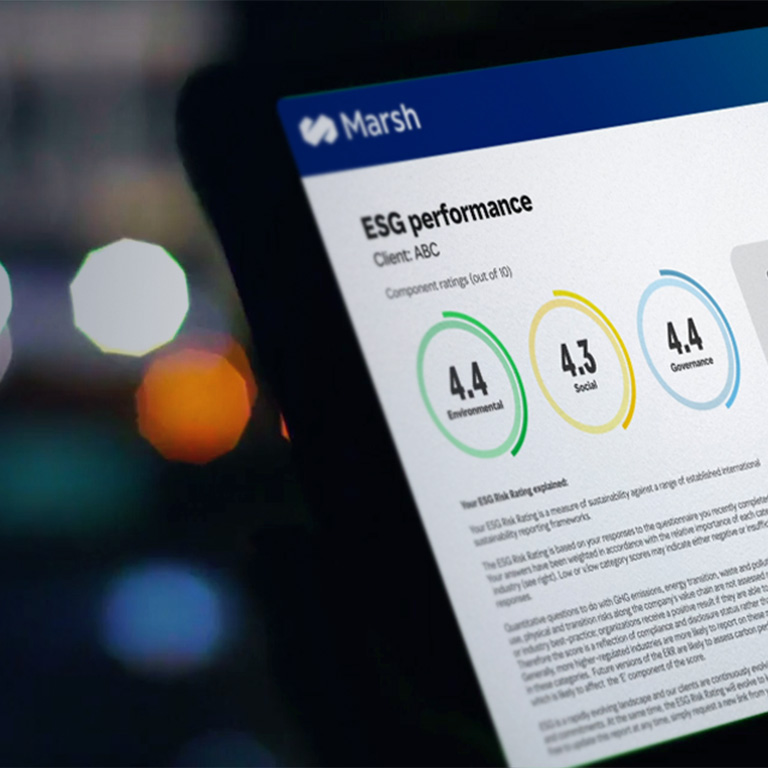
By Amy Barnes ,
Head of Climate & Sustainability Strategy
15/07/2022 · 5-minute read
Environmental, social, and governance (ESG) is already on the radar of most companies. The acronym is frequently seen on corporate websites, annual reports, and press releases, demonstrating that businesses are eager to engage — and to be seen to be engaging — with ESG as a whole.
ESG-related issues are a growing priority for governments and legislators, too. They were high on the agenda at the delayed World Economic Forum (WEF) meeting in Davos in May 2022. The complex question of how to tackle ESG issues at the same time — to both protect the environment while simultaneously fostering healthy societies and growing economies — was also one of the major themes of the WEF’s Global Risks Report 2022.
The problem companies face is therefore not one of awareness, but of action. Many businesses are genuinely committed to engaging with ESG issues. But what are the next steps they should take? And how can they make meaningful (and measurable) improvements in each of these three key areas?
One common obstacle is a lack of clarity, data, and rigorous analysis of a company's actual ESG performance. This often starts with an overemphasis on environmental issues and a relative lack of focus on social and governance issues. As a result, the E overshadows the S and the G, distorting the true nature of the underlying risks.
To give companies a clear, balanced, and more granular view of their ESG performance, Marsh recently launched an innovative ESG Risk Rating tool. This free self-assessment gives businesses a quantitative rating of their organization’s ESG performance measured against 10 internationally recognized standards and frameworks. These include those set out by the Global Reporting Initiative (GRI), Sustainability Accounting Standards Board (SASB), the Task Force on Climate-related Financial Disclosures (TCFD), and the WEF.
Marsh’s ESG Risk Rating tool contains several innovative features, including the fact that it is equally useful to private and publicly listed companies and that it provides both an overall ESG rating and detailed performance scores across 18 separate ESG themes. This level of detail gives companies a robust set of metrics to share with stakeholders as well as a series of data-led insights and practical recommendations — allowing them to measure, analyze, and improve their ESG performance over time. Here is how the tool works and why it could help your company.
The first step towards improving your company’s ESG risk rating is to establish a clear baseline of current performance. Using the answers provided by a comprehensive self-administered questionnaire, Marsh’s tool generates an ESG Risk Rating scorecard that measures your company’s credentials against a range of international standards and other recognized frameworks. The scorecard includes individual ratings on 18 ESG themes, ranging from “Climate Change” and “Biodiversity and Nature Loss” to “Dignity and Equality”, “Ethical Behavior”, and “Skills for the Future”. The tool’s ratings also differentiate between more than 60 industries, recognizing the relative importance of different ESG themes in different sectors.
The insights revealed by the ESG Risk Rating scorecard will enable your company to create a formal ESG risk register, which can be developed through gap-analysis exercises and expert-led workshops. A risk register should highlight ESG-related risks, such as potential future disruptions to your supply chain, while also highlighting how ESG issues could feed into and amplify other corporate risks. In the fashion industry, for example, ESG concerns are likely to be significant drivers of reputational risk. The risk register then becomes a formalized way to inform and advise leadership and other stakeholder groups about the ESG risks and opportunities currently facing your company.
The next step of the process is to use quantitative data to provide a deeper analysis of your company’s exposure to ESG risk. This requires the measurement and prioritization of the potential risks ESG-related issues could pose to your business and its supply chain. Supply chains are a crucial area to model in this way because they can create significant ESG risks for your company. For example, if one of your suppliers is publicly accused of adopting forced labor practices or being involved in modern slavery, this is likely to create serious reputational and financial risks to all the businesses within its supply chain, including yours. When attempting to quantify the full extent of your company's exposure to environmental risk, it is important to be aware that an estimated 80% of most consumer companies' carbon emissions are created within their supply chains.[1]
Regular and robust ESG reporting is now increasingly required to satisfy internal and external stakeholders, and to comply with the reporting requirements (both mandatory and voluntary) of bodies such as the TCFD and legislation such as the EU’s new Corporate Sustainability Reporting Directive (CSRD), which requires all large companies to publish regular reports on their environmental and social impacts. However, it is important to highlight that Marsh’s Risk Rating tool is not a one-off report or simple badge of attainment. It also makes a series of ESG recommendations specific to your business, advising how to improve your ESG controls, reporting, and resilience. This will help to ensure your response to ESG risk is flexible and adaptive.
The final stage of the process is to adopt a series of medium- and long-term strategies to reduce your company’s exposure to ESG risk. A likely benefit of this approach will be the reduction in the cost of transferring any remaining, unmitigated risk through insurance policies. However, perhaps the greatest positive impact that Marsh’s new ESG Risk Rating tool will have is by helping your company to improve its ESG performance (and rating) over time. This is why the tool’s ESG Risk Rating scorecard is so detailed and comprehensive: It is designed as both a spur to action and a way to initiate an ongoing process of ESG measurement — and improvement — within your company.
[1] In the race against time to cut emissions, companies’ supply chains are key | Reuters

Article
08/03/2022